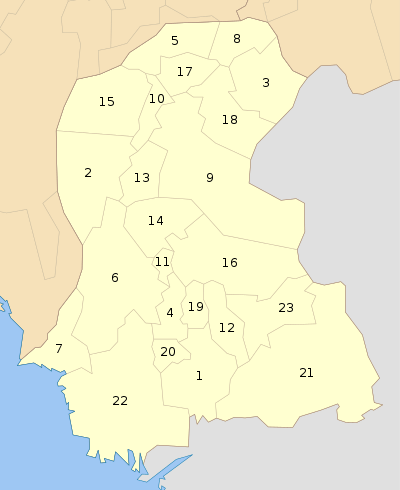Matiari District
Matiari District (Sindhi: ضِلعو مٽیاري) is a district in the Pakistani province of Sindh. The district was created in 2005 out of Hyderabad District.[2]
Matiari District ضِلعو مٽیاري | |
|---|---|
 Map of Sindh with Matiari District highlighted | |
| Country | Pakistan |
| Province | Sindh |
| Established | 2005 |
| Headquarters | Matiari |
| Area | |
| • Total | 1,417 km2 (547 sq mi) |
| Population (2017)[1] | |
| • Total | 769,349 |
| • Density | 540/km2 (1,400/sq mi) |
| Time zone | UTC+5 (PST) |
| Number of Tehsils | 3 |
| Website | http://www.matiari.net/ |
Etymology
The word Matiari is derived from two Sindhi words "Mat" and "yari" which means Change friendship. This is not actually we mean it.
Actually there is a main Bus Stop At Matiari Main Road, Where a Lady has Sat there Hut a long time ago, Where She Keeps a Mud Pot Of Water ( Called in Sindhi like Mat / Matko / Dilo ) , So People of Matiari naming of their Bus Stop, and Telling to Bus Conductor (Make Stop at Old Women's Hut Where She Keeps Mud Pot of Water { called in sindhi like this [ Mat Wari Maai ] }), By Calling it like this (Mat Wari Maai -- Mat Wari Maai )So many time, That is Why it Became Matiari.
History and Administration
Matiari district was carved out of then Hyderabad district in 2005. Matiari district is part of Hyderabad division. The district is administratively subdivided into three talukas:[3]
There are 30 union councils in the district as tabulated below[4]:
| UC
No. |
Name | UC
No. |
Name | UC
No. |
Name | UC
No |
Name | UC
No. |
Name | UC
NO. |
Name |
|---|---|---|---|---|---|---|---|---|---|---|---|
| 1 | Matiari | 6 | Bau Khan
Pathan |
11 | Oderolal | 16 | Bhanoth | 21 | Makhdooman
Jon Landhiyoon |
26 | Bhaledino
Kaka |
| 2 | Jiandal Kot | 7 | Palijani | 12 | Nobat Marri | 17 | Khandu | 22 | Karam Khan
Nizamani |
27 | Sikenderabad |
| 3 | Shah Alam
Ji Wasi |
8 | Oderolal | 13 | Sher Muhammad
Thorra/Kheber |
18 | Fateh
Muhammad Shah Ajnani |
23 | Shahmir
Rahu |
28 | Zair Peer |
| 4 | Shahpur/
Arif Khatian |
9 | Bau Dero | 14 | Faqir Nooh
Hothiani |
19 | Ajan Shah | 24 | Faqirabad | 29 | Abdul Wahid
Borero |
| 5 | Tajpur | 10 | Sekhat | 15 | Muhammad
Hussain Hingoro |
20 | Bhit Shah | 25 | Saeedabad
Old |
30 | Muhammad
Ramzan Unar |
Demography
The total population of district Matiari according to 2017 census was recorded to be 769,349. In the 1998 census, Sindhi was the first language of 92% of the population in the talukas of Hala and Matiari, while 3.6% had Urdu.[5]
Famous places
The shrines of Pir Rukun-Din-Shah, Makhdoom Sarwar Nooh, Shah Abdul Latif Bhittai, Sakhi Hashim Shah pir Haider shah and so many others are located in Matiari district. Miani forest and battle ground of Sir Charles Napier and Talpur rulers of Sindh, Miani jo Maidan are also situated in Matiari district.
Syed Rukun-Din-Shah also fought battle with arguns dynasty with seven bilalis of sindh.
There is also a place named Khuda aabad in Taluka Hala New, Where you can find the graves and the tombs of Mughal Empires era, but it is heard by the locals that graves refers to Mughals, and also there is a Masjid ( Praying Place ) and a Well of Water.
There is also a River named Indus River, where you can reach by Hala Old Village or Bhanoth Village.
Agriculture
Matiari district is one of the most fertile districts of Sindh, main crops cultivated here are Cotton, Banana, Mango, wheat, onions and Sugar-cane.
Handicrafts
This district is famous for its Handicrafts mainly Kaashi and Ajrak produced specially in Hala.
Politics
The elected representative from Matiari district are
- MNA Makhdoom Jameel-uz-Zaman (PPPP) NA 223
- MPA Makhdoom Mehboob Zaman (PPPP) PS 58
- MPA Makhdoom Rafique Zaman (PPPP) PS 59
References
- "DISTRICT WISE CENSUS RESULTS CENSUS 2017" (PDF). www.pbscensus.gov.pk. Archived from the original (PDF) on 2017-08-29.
- District Profile: Upper Sindh - Matiari
- "NRB: Local Government Elections". nrb.gov.pk. Archived from the original on 26 March 2012. Retrieved 27 January 2012.
- "Matiari District UC List, MNA MPA Seats مٹیاری ضلع کی یونین کونسلز". Political, Sports Workers Helpline. 2017-03-02. Retrieved 2020-02-16.
- PCO 1999, p. 117–119.
Bibliography
- 1998 District census report of Hyderabad. Census publication. 59. Islamabad: Population Census Organization, Statistics Division, Government of Pakistan. 1999.
